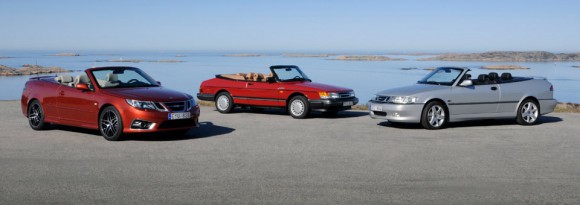2011 marks the 25th anniversary of the launch of Saab’s iconic Convertible, which has played a leading role in growing and moulding the shape of the automotive landscape.
Three generations of Saab Convertibles have hit the road in the last quarter of a century and almost 300,000 have been sold around the world, establishing the vehicle as a global icon for the brand. Offering a comfortable and enjoyable drive come rain or shine, hot or cold, the iconic soft-top car has accounted for as much as fifty percent of total sales in Europe.
Saab’s love affair with the convertible started back in 1986 when production of the first Saab 900 Convertible began. At a time when the convertible was almost extinct The Saab 900 along with BMW 3-Series Convertible changed perceptions of open-top motoring and revitalised a declining market. The fact that a car designed to exploit sunshine and warm weather should be built in a land of snow and ice added to the Convertible’s mystique and its growing cult status while its build quality and lack of drafts and leaks made the convertible desirable once again. A convertible was now a not just a second car used just when the sun shined but a useable every day car. Add to this reasonable luggage space and useable rear seats the Saab Convertible could even be considered as practical.
Seven years later and a second generation came to the market. Autumn 1993 saw the all-new Saab 900 Convertible arrive under the banner: “We didn’t invent the Convertible, but we made a Saab of it.”
This second generation model and its Saab 9-3 evolution in 1998 became an icon, with more stylish design, a move to a hydraulically –powered soft top and increased storage capacity.
2003 brought a whole host of innovations to the Saab Convertible with the launch of the third and current generation, which features the fastest soft-top in operation in its segment, automatic climate control adjustment for a ‘top down’ heating mode and unique Hydroblox water repellent textile seat upholstery, and automatic climate control adjustment for a ‘top-down’ heating mode.
Always the innovator, the current Saab Convertible was the first soft-top car to achieve a maximum, five star EuroNCAP rating for its ‘DynaCage’ rollover protection, pop-up rear roll bars and integrated front seatbelts.
Saab has had a rather sad history in recent years. Taken over by General Motors it was given very limited resources for development resulting in cars that struggle to compete with the best in their class. Sold off during the height of the recession to Spyker a tiny builder of hand crafted luxury sports cars it’s future remains in jeopardy.
The latest news that Swedish Automobile (Spyker’s new name) is unable to pay wages without further external funding is hardly a surprise. Let’s hope the company can get through this difficult period and make a return to the quirky but high quality cars they were once famous for.
Saab 9-3 Convertible by Numbers
The latest Saab 9-3 Convertible is the result of 25 years’ experience in designing and engineering soft-top automobiles. To celebrate the Saab Convertible’s its first quarter century, here are a few fast facts:
3 most popular colors are: Black, Steel Grey and Silver
6 swiveling cross-braces are used in the soft-top to ensure it is tightly stretched in the raised position with a minimum of sagging
7 hydraulic cylinders are used to execute four different movements in the operation of the soft-top.
11 manual heat settings replace the automatic climate control when the soft-top is down. When it is back up, the climate control function is automatically reinstated, complete with any previously saved settings.
20 seconds is the time required to fully deploy the powered soft-top with the engine is running, making it among the fastest-acting in the premium convertible segment.
21 degrees is the ideal back-rest inclination for rear passenger comfort and this was a requirement for the 9-3 Convertible, despite the packaging constraints of soft-top stowage in the trunk.
26 meters is the total length of the hydraulic hoses used in the roof system
30 km/h is the maximum vehicle speed at which the soft-top can be raised. There’s no need to come to a stop to raise the roof if it starts to rain.
140 bar is the hydraulic pressure required to operate the soft-top – 56 times greater than normal tire pressure.
181 is the number of moving parts in the soft-top mechanism. The main roof structure, including the front header rail, is made from magnesium to save weight.
366 is the number of Saab 9-3 Convertible Independence Editions being built
1,500 liters of water is sprayed over the Convertible’s soft-top in a special chamber to check weatherproofing.
3,500 kilo, or more than twice the weight of the car, is the impressive load that the windshield header rail and its supporting A-pillars can carry. Necessary strength for rollover protection and good torsional rigidity.
Saab celebrated the first anniversary of its rebirth as an independent company in February 2011 by launching an exclusive Independence Edition of its 9-3 Convertible.

By submitting a comment you grant Convertible Car Magazine a perpetual license to reproduce your words and name/web site in attribution. Inappropriate and irrelevant comments will be removed at an admin’s discretion. Your email is used for verification purposes only, it will never be shared.